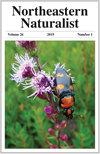在新英格兰南部,稀有的北方植物物种正在从它们活动范围的南部边缘撤退吗?
IF 0.5
4区 环境科学与生态学
Q4 BIODIVERSITY CONSERVATION
引用次数: 1
摘要
摘要:近年来的气候变暖被广泛认为会引起动植物物种地理分布的变化。这种变化的潜在证据包括在冷范围边缘的种群扩张和在暖范围边缘的种群收缩。我们利用来自植物标本馆和国家自然遗产项目的城镇级发生数据,根据历史和当前记录的差异,评估新英格兰南部一组稀有(国家上市)北部植物物种的潜在范围缩小的证据。为了进行比较,我们研究了南方稀有物种和既不是北方也不是南方(中部)的稀有物种的样本。在北部和中部样本中,有当前事件的城镇的年平均气温显著低于只有历史事件的城镇,而在南部样本中则没有。一个潜在的混淆变量是人类对自然栖息地的改变,我们使用人口密度作为代理。在南部和中部样本中,历史上发生过这种情况的城镇的人口密度明显高于目前的城镇,但在北部样本中却没有,这表明人类存在较多的城镇的总体损失更大。为了分离人类栖息地变化和温度的潜在影响,我们分析了城镇温度对人口密度的回归残差。当将历史城镇和当前城镇进行比较时,北部和中部样本中当前城镇的这些残差都明显较低,这表明气候的影响超出了人类栖息地改变的范围。相比之下,对于稀有的南方物种,当前城镇的剩余量大于历史城镇,这表明这些物种并没有不成比例地从温暖的城镇消失。这是显示一组植物物种的暖缘范围收缩的少数研究之一,显然也是唯一一个考虑到人类栖息地改变的潜在混淆效应的研究。我们的研究结果强调了植物标本馆标本与最近的调查相结合的价值,以记录这些变化,并指出在任何此类分析中考虑潜在混淆因素的重要性。本文章由计算机程序翻译,如有差异,请以英文原文为准。
Are Rare Northern Plant Species Retreating from the Southern Edge of Their Ranges in Southern New England?
Abstract - Recent climatic warming is widely expected to cause changes in the geographic distributions of plant and animal species. Potential evidence of such changes includes expansion of populations at the cool range margin and contraction of populations at the warm range margin. We made use of town-level occurrence data from herbaria and state natural heritage programs to assess evidence of potential range contraction in a group of rare (state-listed) northern plant species in southern New England based on differences between historical and current records. For comparison, we examined samples of rare southern species and rare species that were neither northern nor southern (central). The mean annual temperature of towns with current occurrences was significantly lower than in towns with only historical occurrences in the northern and central samples, but not in the southern sample. A potentially confounding variable was human alteration of natural habitats, for which we used human population density as a proxy. Towns with historical occurrences had significantly higher population densities than current towns in the southern and central samples but not in the northern sample, representing a greater overall loss in towns with greater human presence. To separate the potential effects of human habitat alterations and temperature, we analyzed residuals from a regression of town temperature on human population density. When compared between historical and current towns, these residuals were significantly lower in current towns for both the northern and central samples, indicating an effect of climate beyond what could be accounted for by human habitat alterations. For rare southern species, in contrast, the residuals were greater for current than historical towns, indicating that these species were not being disproportionately lost from warmer towns. This is one of a small number of studies that show warm-edge range contractions in a group of plant species, and apparently the only one to consider the potentially confounding effects of human habitat alteration. Our results highlight the value of herbarium specimens in conjunction with recent surveys to document such changes and point to the importance of considering potentially confounding factors in any such analysis.
求助全文
通过发布文献求助,成功后即可免费获取论文全文。
去求助
来源期刊

Northeastern Naturalist
环境科学-生态学
CiteScore
1.10
自引率
0.00%
发文量
42
审稿时长
18-36 weeks
期刊介绍:
The Northeastern Naturalist covers all aspects of the natural history sciences of terrestrial, freshwater, and marine organisms and the environments of the northeastern portion of North America, roughly bounded from Virginia to Missouri, north to Minnesota and Nunavut, east to Newfoundland, and south back to Virginia. Manuscripts based on field studies outside of this region that provide information on species within this region may be considered at the Editor’s discretion.
The journal welcomes manuscripts based on observations and research focused on the biology of terrestrial, freshwater, and marine organisms and communities as it relates to their life histories and their function within, use of, and adaptation to the environment and the habitats in which they are found, as well as on the ecology and conservation of species and habitats. Such studies may encompass measurements, surveys, and/or experiments in the field, under lab conditions, or utilizing museum and herbarium specimens. Subject areas include, but are not limited to, anatomy, behavior, biogeography, biology, conservation, evolution, ecology, genetics, parasitology, physiology, population biology, and taxonomy. Strict lab, modeling, and simulation studies on natural history aspects of the region, without any field component, will be considered for publication as long as the research has direct and clear significance to field naturalists and the manuscript discusses these implications.
 求助内容:
求助内容: 应助结果提醒方式:
应助结果提醒方式:


